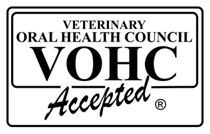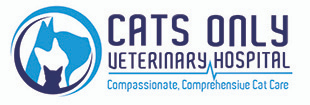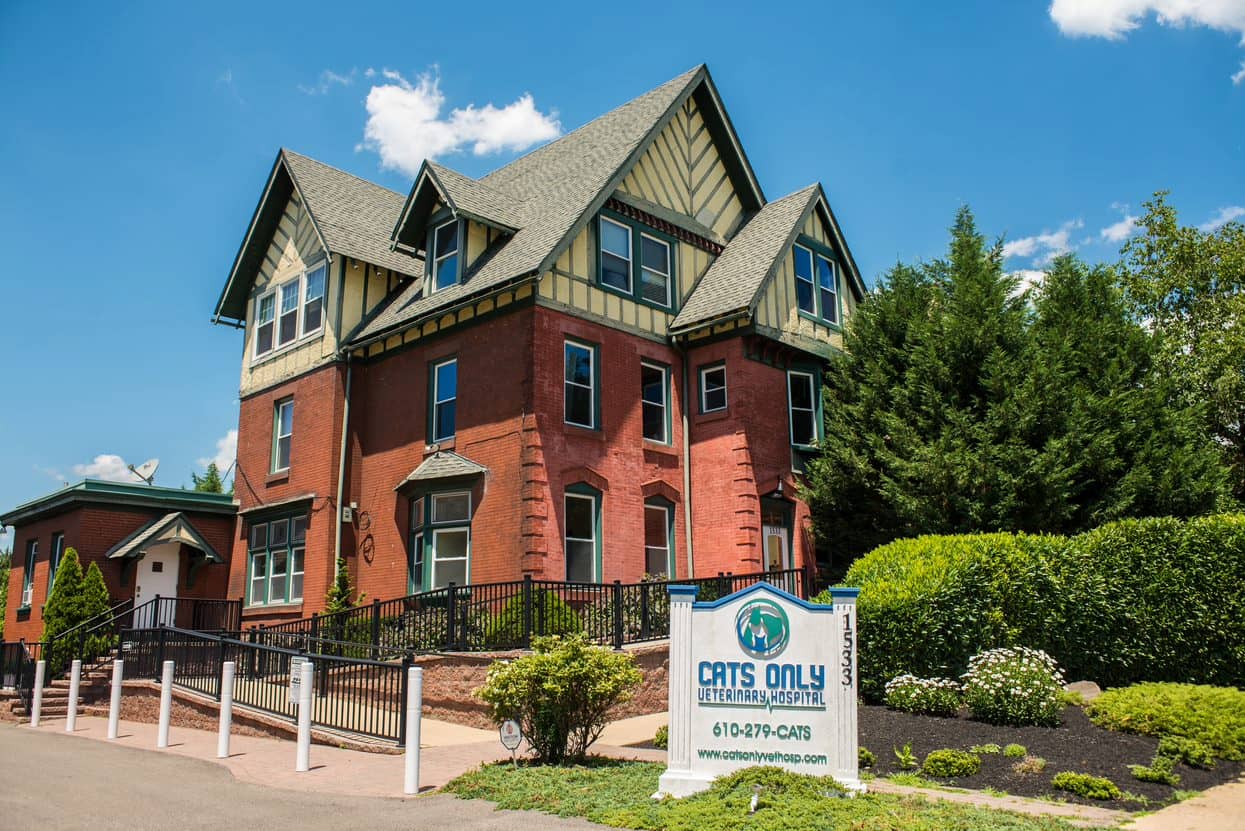Dental Care
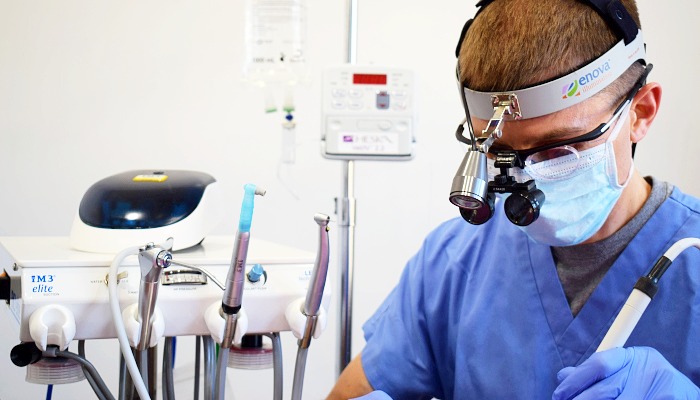
Your cat’s dental health is very important to us. Approximately 70% of cats over the age of 2 to 3 have some degree of periodontal disease (tartar, plaque, gingivitis, tooth resorption). Each comprehensive physical examination will include an evaluation of your cat’s mouth.
Our Dental Package Includes:
- IV catheter & IV fluids
- Pre-medications to relax your cat & lower anesthesia medications
- Propofol anesthesia induction (very safe anesthesia)
- Anesthesia monitoring by a trained technician
- Full mouth digital, dental radiographs (x-rays)
- Ultrasonic teeth scaling
- Teeth polishing
- Fluoride treatment
- Class IV Laser treatment
If dental extraction(s) are required, your cat will have the following:
- Antibiotic injection prior to surgery
- Anti-inflammatory injection prior to surgery
- Post-operative digital dental radiographs (x-rays) for each extraction
- Antibiotics to administer at home
- 2 Pain medications to administer at home
- Summary of the findings & dental radiographs (x-rays) with the doctor
- Written discharge instructions
- Follow-up call the next day
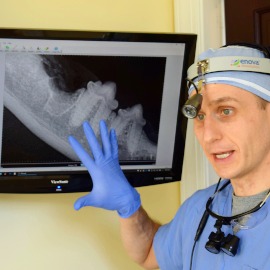
Digital Dental Radiographs (X-Rays)
Dental radiographs are vital to any dental procedure as two-thirds of your cat’s tooth lies below the gingiva. All patients will have full mouth dental radiographs taken under anesthesia prior to any dental procedure. Often times significant disease lies under the gum line and may be undetected without utilizing dental radiographs. A diagnosis and treatment plan can only be completed after full mouth dental radiographs are evaluated by a veterinarian. If an extraction is required, post-operative dental x-ray(s) will be taken to ensure all root(s) were extracted.
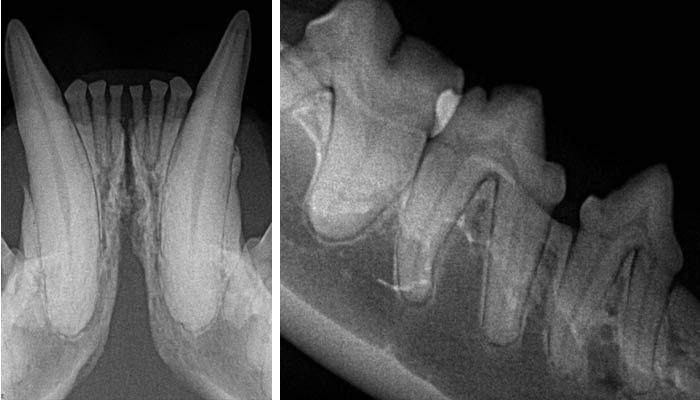
Why so much concern about my cat’s mouth?
A healthy mouth means your cat has great quality of life. Since cats are notorious for hiding pain and discomfort, you may not know there is problem in cat’s mouth. Often times, owners see dramatic change their personality behavior after dental procedure. An unhealthy mouth can affect cats’s kidneys, liver and heart.
When should I have my cat’s mouth cleaned?
A dental cleaning is typically recommended when (1) gingivitis, the first stage of periodontal disease, is present or (2) significant accumulation of tartar has occurred. Gingivitis is a reversible stage of dental disease. If it is allowed to progress, irreversible dental disease may result and tooth extraction may be required.
Why is anesthesia required for a dental procedure?
Anesthesia is required for a dental cleaning and/or extractions. Simply “plucking off tartar” is a disservice to your cat. Dental disease begins under the gum line and this is the cause for gingivitis, even if there is not a significant amount of tartar on the tooth. “Plucking” tartar off the tooth will not address the tartar and plaque under the gum line. Anesthesia allows a veterinarian to evaluate the entire mouth, not just the outside of the teeth, and includes (1) all surfaces of the tooth (i.e. the inside of the tooth), (2) other structures in the mouth (i.e. tongue, larynx), and (3) the tooth roots with dental x-rays. Even though we get a sense of the disease in your cat’s mouth at their comprehensive physical examination, often times there is disease hiding in the mouth, especially under tartar. Anesthesia allows the veterinarian to chart the entire mouth, taken full mouth dental x-rays, scale all surfaces of the tooth, scale under the gum line, extract diseased teeth only if necessary, polish each tooth, and apply fluoride to each tooth. All of these services are performed with each dental cleaning and cannot be performed in an awake cat.
We strive to take every precaution possible to decrease the risks of general anesthesia for your cat. Prior to a surgical procedure, our hospital requires a comprehensive physical examination and pre-anesthetic screening within one month of the procedure. These pre-surgical requirements are to give us a more complete picture of your cat’s health, to gain as much information as possible prior to anesthesia, identify potential underlying medical conditions that may pose problems with anesthesia, and to tailor an anesthetic protocol specifically to your individual cat.
Each of our surgical patients will have pre-medications administered to (1) relax your cat prior to the procedure and (2) reduce the amount of anesthesia required. Anesthesia is typically induced with propofol, a very safe and fast acting medication, and maintained with gas anesthesia after intubation. Each patient will have an intravenous (IV) catheter, fluids administered during the surgery, and be monitored throughout the procedure with these parameters: (1) blood oxygen levels, (2) blood carbon dioxide levels, (3) blood pressure, (4) EKG, (5) heart rate, (6) respiratory rate and (7) temperature.
Where do these recommendations come from?
There are two veterinary dental organizations that give guidelines regarding proper dental recommendations and care. You may visit their websites below.


Preventative Dental Homecare
Prevention is key for a healthy mouth! Preventative dental homecare is also a major focus of our hospital since dental disease is uncomfortable (and potentially life threatening if severe) and we would prefer our patients to keep all of their teeth. Dental home care is recommended ONLY when there is minimal dental disease present or immediately following a professional dental cleaning. If your cat has dental disease present (i.e. plaque and tartar), the following recommendations will not treat the dental disease and a professional dental cleaning should be pursued. Additionally, attempting dental prevention at home while dental disease is present may result in pain and may prevent any future attempts at dental homecare. Below are some recommendations to keep your cat’s mouth healthy and happy. Our staff will be happy to discuss these options with you.
Recommendation #1: Brushing Your Cat’s Teeth
There is no substitute to brushing your cat’s teeth with a soft bristled toothbrush once daily. Use a veterinary toothbrush (i.e. C.E.T) or a soft bristle children’s toothbrush from your local grocery store. Finger brushes are not recommended because your cat may bite your finger and these toothbrushes do not have adequate bristle action along the gum line. Brushing should begin during the kitten stage of life after the adult teeth have erupted when there is no visible plaque and tartar in the mouth. For adult cats that are not accustomed to having their teeth brushed, the approach below is recommended. Continue with each step until your cat becomes comfortable with that step (each step may take days to weeks depending on the cat). Be patient. A slow, consistent approach (same family member, same time of day, same location, tasty treat after a brushing, etc.) is also advisable. If your cat is having a bad day, give your cat a break and try the next day. Do not force any step on your cat. Doing so may compromise any future attempts at brushing your cat’s teeth. Please visit the link below for an educational video on how to brush your cat’s teeth.
- Stroke your cat’s lips and muzzle without opening their mouth. Your cat should become comfortable with you touching the outside of their mouth before proceeding to the next step.
- Place a toothbrush with C.E.T. poultry or seafood flavored toothpaste (do not use human toothpaste) on a flat surface for your cat to investigate. Give your cat a treat when they investigate the toothbrush and/or put the toothbrush in your cat’s food dish. Be creative with the early introduction of the toothbrush. The goal here is to create positive feelings towards the toothbrush before you begin to brush your cat’s teeth. Once your cat is used to having their muzzle touched and is familiar with their toothbrush, proceed to the next step.
- Lift your cat’s lips without opening your cat’s mouth. Massage the gums and teeth with the toothbrush, beginning with the front teeth. Continue this process until you are able to brush the upper back teeth. Make sure your cat does not bite you! You may place some toothpaste on your finger during this step. Once your cat is comfortable touching and massaging their gums, proceed to the next step.
- Try opening your cat’s mouth slightly and lifting the lips. Your goal is to visualize the upper back teeth in the mouth. Once you feel comfortable with this step, start brushing the outside of all teeth at the gum line with a toothbrush and toothpaste once daily.

Recommendation #2: VOHC Approved Dental Diets
If you cannot brush your cat’s teeth, there are veterinary approved dental diets & treats that have been proven to reduce and prevent plaque and tartar. Your average dry diet DOES NOT protect your cat’s teeth from plaque and tartar. All dental diets and treats should have the VOHC (Veterinary Oral Health Council) seal. Visit the VOHC website (link is below) for a list of approved dental diets and treats. Only the following diets and treats have been awarded the VOHC seal:
- Purina DH Dental Health Veterinary Diets
- Hill’s t/d Prescription Diet
- Science Diet Oral Care Diet for Cats
- Royal Canin Feline Dental Diet
- Purina Dentalife Treats
- Greenies Treats
